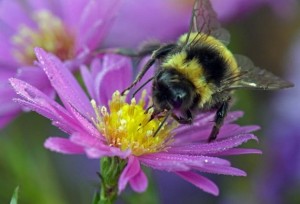Sunday Times 2
European bumblebees at risk of extinction
A quarter of the bumblebees in Europe are at risk of extinction as their habitats are destroyed, according to a new report.
The loss of the bees will place farming in crisis because of the insects’ vital role in pollinating crops, claim conservationists.
Sixteen of 68 bumblebee species in Europe are at risk, according to the Red List of the International Union for Conservation of Nature (IUCN).

A quarter of the bumblebees, stock image pictured, in Europe are at risk of extinction as their habitats are destroyed, according to a new report. The loss of the bees will place farming in crisis because of the insects' vital role in pollinating crops, claim conservationists(AFP)
Some 26 of the listed species live in Britain, of which 12 are decreasing, six are stable and five increasing.
The IUCN, which brings together governments, scientists and conservation groups, said: ‘Of the five most important insect pollinators of European crops, three are bumblebee species.
‘Together with other pollinators, bumblebees contribute more than £18billion (€22 billion euros) to European agriculture a year,’ its report said.
The biggest threat to bumblebees is the destruction of wildflower meadows which gives them a food supply.
The mass use of herbicides and pesticides has also been a big blow, with chemicals used to remove ‘weeds’ such as clover from farmlands that the insects feed on.
Half of Europe’s bumblebee species have falling populations and just 13 per cent are increasing, it said.
The report, which is the first Red List assessment of the threats to bumblebees, said: ‘Climate change, the intensification of agriculture and changes in agricultural land are the main threats.
The European Union’s top environment official said the EU’s 28 nations were taking action to improve the situation.
EU Environment Commissioner Janez Potocnik said: ‘The EU recently banned or restricted the use of certain pesticides that are dangerous to bees and is funding research into status of pollinators.
‘However, efforts clearly need to be scaled up.’ Recent studies have found that diseases from commercial honeybee hives are spreading to bumblebees.
A study in the journal Nature said that deformed wing virus, for instance, was found in both honeybees and bumblebees in Britain.
The virus was more prevalent in honeybees, suggesting it was spreading from them to bumblebees.
© Daily Mail, London


